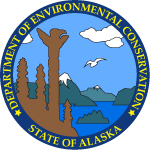| Action Date |
Action |
Description |
DEC Staff |
| 9/28/2012 |
Spill Transferred from Prevention Preparedness and Response Program |
Spill transferred by PERP staff Ashley Anderson. Spill no. 12399914301; spill date = 5/22/12; substance = ultra low sulfur diesel; quantity = ~300 gallons; PERP file no. 300.02.107. |
Mitzi Read |
| 10/19/2012 |
Site Added to Database |
A new site has been added to the database |
Mitzi Read |
| 10/31/2012 |
Document, Report, or Work plan Review - other |
Reviewed Colville Tank Farm Tank 701 Secondary Containment Area Spill Cleanup Report. The spill outside of containment occurred after diesel fuel was released from Tank 701 to containment, then in an effort to recover the fuel more easily, the secondary containment area was flooded with water, making it apparent that three seams had failed in the liner as diesel contaminated water was discharged to the area around the secondary containment. Spill cleanup was conducted at four separate areas, A-D. At Area A, soil was removed to a depth of six inches bgs. Confirmation samples contained DRO up to 57 mg/kg. At Area B, soil was generally removed to a depth of 1 foot, however two hotspots were excavated to 4-4.5 feet bgs. Confirmation samples contained DRO up to 350 mg/kg. At Area C, one foot of soil was removed. A strong gasoline odor was noted, potentially indicating a different spill had been encountered so excavation stopped. Confirmation samples contained DRO up to 1,700 mg/kg and GRO up to 1,600 mg/kg. At Area D, six inches of soil was removed. Confirmation samples contained DRO up to 130 mg/kg. All excavations were guided by a PID and approximately 100 cy of soil was transported to AIC for thermal treatment. |
Bill O'Connell |
| 10/31/2012 |
Potentially Responsible Party/State Interest Letter |
|
Keather McLoone |
| 5/29/2013 |
Update or Other Action |
Deadline for work plan submission extended until the end of June, 2013. Upgrades are planned for this facility that may directly impact this investigation, so the work plan will be submitted once the scope of the upgrades and schedule are known. |
Bill O'Connell |
| 7/8/2013 |
Document, Report, or Work plan Review - other |
Reviewed Site Investigation work plan for Colville Tank Farm. The objective is to characterize the nature and extent of hydrocarbon contamination from historic fuel spills near the former tank farm. Ten or more soil borings will be advanced to below the pad/tundra interface and interface and up to 20 soil samples will be collected. |
Bill O'Connell |
| 10/11/2013 |
Document, Report, or Work plan Review - other |
Date of receipt via email of Draft Site Investigation Report, Collville Former Tank Farm submitted by ERM. This effort was primarily to characterize an area previously identified as a historic GRO release in "Area C" via testpitting in 2012. Ten borings were advanced in 2013 and samples analyzed for GRO, DRO, and BTEX. Results for GRO, DRO, benzene and total BTEX were above Method One criteria in the western portion of investigation area at depths ranging from 1.5 to 5.5 feet bgs with tundra/native material being encountered at 4-5 ft bgs, generally. ERM recommends a building survey for Warehouse #2 and meltwater sampling to assist in evaluating the vapor intrusion pathway. |
Keather McLoone |
| 11/8/2013 |
Document, Report, or Work plan Review - other |
Date of receipt of Final Site Investigation report. After communication with consultant regarding the need for remedial effort at this site, the final report recommendations are the generally the same as in the draft. |
Keather McLoone |
| 3/28/2014 |
Document, Report, or Work plan Review - other |
Date of receipt of Warehouse #2 Intrusion Pathway Evaluation, Monitoring Well Installation and Sample Workplan via email. Email also on this date indicates that Colville is considering an excavation effort to attempt to remove the contaminated soil. Email comment to workplan sent via email stated pointing out an incorrect statement in 4th bullet under section 4.4 Data Quality Objectives regarding the accuracy goal. Correct goal may be a plus or minus 30% accuracy rather than a goal of less than 30%.
ADEC also requested that, if removal of contaminated gravel/soil is not part of the planned 2014 construction activities, we be notified as soon as possible so that there could be a discussion prior to construction planning without a removal action as part of the intended activities.
|
Keather McLoone |
| 5/30/2014 |
Update or Other Action |
On today's date consultant informed ADEC that excavation was no longer anticipated this summer at this site. However, groundwater sampling and the vapor intrusion evaluation would still be conducted. |
Keather McLoone |
| 8/7/2014 |
Document, Report, or Work plan Review - other |
Received on today's date, via email, a signed copy of the Waste Characterization Sampling Plan previously submitted (in draft via email on 5/16/14) and conditionally approved. Email also communicated that waste characterization samples will be collected in and around the plume at the Colville Tank Farm per the attached plan. At this time there are no plans to excavate in the area, this sampling will be done as a proactive step, in the event that construction is done in the future. Also, the following are changes to the previously submitted plan:
• No construction activities are currently scheduled.
• Sampling will occur in mid-August or early September 2014.
• Test pits will go to 4 ft. or frost line.
• Test pits will be screened using a PID and the soil samples will be collected from the highest PID reading.
• No waste, beyond PPE waste, will be produced. Soils will be placed back in the hole in the order it was removed.
|
Keather McLoone |
| 8/7/2014 |
Update or Other Action |
Also submitted on today's date via email, Addendum to Warehouse #2 Vapor Intrusion Pathway,
Evaluation, Monitoring Well Installation and Sample Work Plan. |
Keather McLoone |
| 8/8/2014 |
Site Characterization Workplan Approved |
Letter sent on this date to formalize earlier conditional approval via email of the Waste Characterization plan and the Warehouse #2 Vapor Intrusion Pathway Evaluation, Monitoring Well Installation and Sample Work Plan. Letter also stated that DEC had no objection to the Addendum to the later planning document. |
Keather McLoone |
| 5/18/2015 |
Document, Report, or Work plan Review - other |
Date of receipt via email of Colville Former Tank Farm, Warehouse #2 Vapor Intrusion Pathway Evaluation, Monitoring Well Installation and Sampling Report. Seven borings were advanced, two soil samples collected from each boring, and each boring completed as a monitoring well. Groundwater samples were collected from each well and a building survey was conducted to inform the vapor intrusion pathway. |
Keather McLoone |
| 6/19/2015 |
Document, Report, or Work plan Review - other |
Reviewed the Colville Former Tank Farm Warehouse #2 Vapor Intrusion Pathway Evaluation, Monitoring Well Installation and Sampling Report, dated May 2015. Investigation activities performed at this site in April and August 2014 included advancing numerous soil borings, installing 7 groundwater monitoring wells, collecting soil and water samples as appropriate, and completing a building survey at Warehouse #2 to assess the potential for vapor intrusion. Soil and water analytical results indicate that the contaminant plume is mostly defined; however, the remaining contamination is well above ADEC cleanup standards. Soil analytical results reported in this document include maximum concentrations of 23,500 mg/kg GRO, 3,150 mg/kg DRO, 1,460 mg/kg benzene, 3,440 mg/kg, 933 mg/kg ethylbenzene, and 4,530 mg/kg xylenes. Also, water analytical results included maximum concentrations of 238 mg/L GRO, 7.98 mg/L DRO, 43.3 mg/L benzene, 50.9 mg/L toluene, 4.52 mg/L ethylbenzene, and 24.88 mg/L xylenes. Additionally, several water samples exceeded total aqueous hydrocarbons (TAqH) and total aromatic hydrocarbons (TAH) with concentrations up to 123.39 mg/L and 123.624 mg/L, respectively.
|
Joshua Barsis |
| 9/16/2015 |
Document, Report, or Work plan Review - other |
Reviewed the 2015 Groundwater Long-Term Monitoring Work Plan, dated September 2015. Activities described in the work plan mainly consist of collecting groundwater samples from seven existing monitoring wells on an annual basis. All samples will be analyzed for gasoline range organics (GRO), diesel range organics (DRO), naphthalene, and benzene, toluene, ethylbenzene, and xylenes (BTEX). |
Joshua Barsis |
| 12/21/2015 |
Document, Report, or Work plan Review - other |
Reviewed the Waste Characterization Sampling Plan, dated December 18, 2015. The purpose of the waste characterization effort is to determine if excavated soil (expected to occur in summer 2016) could be classified as hazardous waste. |
Joshua Barsis |
| 2/22/2016 |
Document, Report, or Work plan Review - other |
Reviewed the 2015 Long-Term Groundwater Monitoring Report, dated December 2015. The report described the groundwater monitoring activities completed in September 2015. Seven monitoring wells (MW-1 through MW-7) were purged and sampled in accordance with the 2015 Groundwater Long-Term Monitoring Work Plan. Monitoring Well MW-1 continues to be the most contaminated well with concentrations of GRO at 356 mg/L, DRO at 14.9 mg/L, benzene at 92.7 mg/L, toluene at 65.6 mg/L, ethylbenzene at 5.27 mg/L, and total xylenes at 26.4 mg/L; all of which exceed the ADEC groundwater cleanup levels. Monitoring Wells MW-2 and MW-5 also exhibited levels of benzene above ADEC groundwater cleanup levels. In general, groundwater concentrations have increased as compared to 2014. The next groundwater monitoring event will be performed in September 2016. |
Joshua Barsis |
| 3/2/2016 |
Document, Report, or Work plan Review - other |
Reviewed the 2015 Long-Term Groundwater Monitoring Report, dated December 2015. The report described the groundwater monitoring activities completed in September 2015. Seven monitoring wells (MW-1 through MW-7) were purged and sampled in accordance with the 2015 Groundwater Long-Term Monitoring Work Plan. Monitoring Well MW-1 continues to be the most contaminated well with concentrations of GRO at 356 mg/L, DRO at 14.9 mg/L, benzene at 92.7 mg/L, toluene at 65.6 mg/L, ethylbenzene at 5.27 mg/L, and total xylenes at 26.4 mg/L; all of which exceed the ADEC groundwater cleanup levels. Monitoring Wells MW-2 and MW-5 also exhibited levels of benzene above ADEC groundwater cleanup levels. ADEC requested a revised report by May 1, 2016. A revised report was received with the requested changes on March 9, 2016. LTM monitoring will be completed during summer 2016. |
Joshua Barsis |
| 3/11/2016 |
Document, Report, or Work plan Review - other |
Reviewed the Waste Soil Characterization Report, dated March 7, 2016. Six waste characterization soil samples were collected on January 22, 2016 from three test pits advanced at this site. The purpose of this sampling effort was to determine if excavated soil (planned for summer 2017) would be classified as a Resource Conservation and Recovery Act (RCRA) hazardous waste. Samples were submitted for analysis of gasoline range organics (GRO), diesel range organics (DRO), volatile organic compounds (VOCs), and toxicity leaching characteristic procedure (TCLP) for benzene. Analytical results showed maximum concentrations of GRO, DRO, benzene, and TCLP benzene up to 645 mg/kg, 185 mg/kg, 10.7 mg/kg, and 0.0255 mg/kg, respectively. The Method One cleanup levels for GRO, DRO, and benzene are 100 mg/kg, 200 mg/kg, and 17 mg/kg, respectively. The TCLP regulatory level for determining if a benzene is considered a hazardous waste is 0.5 mg/kg.
The purpose of this report was to determine if the levels of benzene in the subsurface pad material would be considered RCRA hazardous waste. This effort was performed in response to the high levels of benzene shown in the vicinity of Monitoring Well MW-01 (up to 1,460 mg/kg benzene). The concentrations of benzene presented in this report do not accurately represent the levels of benzene that were previously identified; however, the levels of benzene that were previously identified were collected from the tundra mat (not the gravel pad material). Therefore, ADEC does consider this report sufficient for waste characterization purposes, specific to the gravel pad material that is slated for removal in 2017.
|
Joshua Barsis |
| 9/7/2016 |
Document, Report, or Work plan Review - other |
Reviewed the revised Groundwater Long-Term Monitoring Work Plan, dated August 2016 for the Colville Tank Farm site. Proposed activities consist of annual surface water monitoring (if present) and groundwater monitoring of seven wells (MW-01 through MW-07). The tank farm is slated for decommissioning in 2017. At that time, excavation will be required to remove as much impacted material as feasible and a vapor intrusion study will be required at warehouse #2. This work plan is approved with the following conditions. |
Joshua Barsis |
| 1/18/2017 |
Document, Report, or Work plan Review - other |
Reviewed the 2016 Long-Term Groundwater Monitoring Report, dated January 2017. The report describes the groundwater monitoring activities completed on September 7, 2016. Seven monitoring wells (MW-1 through MW-7) and one surface water body were sampled for gasoline range organics (GRO), diesel range organics (DRO), volatile organic constituents (VOCs), and polynuclear aromatic hydrocarbons (PAHs), as appropriate. Well MW-1 continues to be the most contaminated well with concentrations of GRO at 295 mg/L, DRO at 17.4 mg/L, benzene at 84.4 mg/L, toluene at 66.2 mg/L, ethylbenzene at 4.92 mg/L, total xylenes at 25.7 mg/L, and TAH and TAqH both at 180 mg/L. Monitoring Wells MW-2 and MW-5 continue to exceed applicable standards for benzene, TAH and TAqH. DRO was also present in MW-2 above Table C levels. Surface water sample results were all below Alaska Water Quality Standards for TAH and TAqH. |
Joshua Barsis |
| 3/6/2018 |
Document, Report, or Work plan Review - other |
Reviewed the 2017 Long-Term Groundwater Monitoring Report, dated January 18, 2018. The report describes the groundwater monitoring activities completed in August 2017. Seven monitoring wells (MW-1 through MW-7) and one surface water body were sampled for gasoline range organics (GRO), diesel range organics (DRO), volatile organic constituents (VOCs), and polynuclear aromatic hydrocarbons (PAHs). Well MW-1 continues to be the most contaminated well with concentrations of GRO at 279 mg/L, DRO at 15.5 mg/L, benzene at 74.9 mg/L, toluene at 56.5 mg/L, ethylbenzene at 4.32 mg/L, total xylenes at 30.26 mg/L, and TAH and TAqH both slightly above 158 mg/L. Surface water sample results were all below Alaska Water Quality Standards for TAH and TAqH. 2018 report is due January 31, 2019. |
Joshua Barsis |
| 1/28/2019 |
Document, Report, or Work plan Review - other |
Reviewed the 2018 Long-Term Groundwater Monitoring Report, dated November 2018. The report describes the groundwater monitoring activities completed in August 2018. Seven monitoring wells (MW-1 through MW-7) and one surface water body were sampled for gasoline range organics (GRO), diesel range organics (DRO), volatile organic constituents (VOCs), and polynuclear aromatic hydrocarbons (PAHs). Well MW-1 continues to be the most contaminated well with concentrations of GRO at 359 mg/L, DRO at 7.58 mg/L, benzene at 99.2 mg/L, toluene at 64.4 mg/L, ethylbenzene at 5.01 mg/L, total xylenes at 26 mg/L, total aromatic hydrocarbons (TAH) at 195 mg/l and total aqueous hydrocarbons (TAqH) at 235 mg/L. Surface water sample results were all below Alaska Water Quality Standards (AWQS) for TAH and TAqH. |
Joshua Barsis |
| 10/28/2019 |
Document, Report, or Work plan Review - other |
Reviewed the 2019 Long-Term Groundwater Monitoring Report, dated October 2019. The report describes the groundwater monitoring activities completed in Late July 2019. Seven monitoring wells (MW-1 through MW-7) were sampled for gasoline range organics (GRO), diesel range organics (DRO), volatile organic constituents (VOCs), and polynuclear aromatic hydrocarbons (PAHs). The planned surface water sample could not be collected because no surface water was present in the ditch on the western side of the facility, where it was sampled in the past.
Monitoring Well MW-1 continues to be the most contaminated well with concentrations of GRO at 109 mg/L, DRO at 3.84 mg/L, benzene at 7.36 mg/L, toluene at 26.2 mg/L, ethylbenzene at 3.36 mg/L, total xylenes at 19.5 mg/L, total aromatic hydrocarbons (TAH) at 56 mg/l and total aqueous hydrocarbons (TAqH) at 99 mg/L. Surface water sample results were all below Alaska Water Quality Standards (AWQS) for TAH and TAqH. This report is approved.
ADEC concurs with the report recommendations for continued groundwater monitoring and well repair. |
Joshua Barsis |
| 4/20/2020 |
Site Characterization Workplan Approved |
ADEC approves the work plan titled "Former Tank Farm, Site Characterization Plan" dated April 13, 2020. The goal of this work plan is to further characterize benzene in soil to identify concentrations that potentially exceed the hazardous waste threshold. Information from this field effort will be used to develop a plan for contaminant reduction via aeration. |
Kara Kusche |
| 7/16/2020 |
Site Characterization Report Approved |
A letter report TCLP Benzene Site Investigation Report, Former Tank Farm was approved though the department does not agree with all of the conclusions. The report described advancing 26 borings within in the source area to prepare for anticipated tank farm expansion. A total of 35 samples were collected and analyzed for BTEX. Sample depths ranged from 1.5 to 5 feet. Several of the samples were also analyzed for benzene by TCLP to determine if future waste generated would be toxicity characteristic RCRA waste. None of the samples exhibited toxicity characteristic, though the sample from SB04-4.5 was close to toxicity characteristic with 0.473 mg/L. TCLP benzene was not analyzed in SB24-3.8 however it had the highest total benzene concentration at 1,500 mg/Kg (two orders of magnitude above the human health cleanup level). Eighteen other samples exceeded human health cleanup levels for total benzene. High levels of benzene contamination remain in the source area surface and subsurface soils.
|
Lisa Krebs-Barsis |
| 10/21/2020 |
Site Characterization Report Approved |
The 2020 Long-Term Groundwater Monitoring report submitted September 2020 was approved. Seven wells (MW-01 through MW-07) were sampled for GRO, DRO, VOC, and PAH. At MW-01 groundwater cleanup levels were exceeded for GRO, DRO, benzene, toluene, ethylbenzene, total xylenes, 1,2,4-trimethylbenzene, and 1,3,5-trimethylbenzene. In MW-02 benzene exceeded groundwater cleanup levels. In MW-03 naphthalene exceeded cleanup levels. In MW-04 benzene and naphthalene exceeded cleanup levels. In MW-05 GRO, DRO, benzene, ethylbenzene, naphthalene, 1,2,4-trimethylbenzene, and 1,3,5-trimethylbenzene exceeded cleanup levels. No exceedances were detected in MW-06 and MW-07. A surface water sample was not collected because there was no surface water present. |
Lisa Krebs-Barsis |
| 7/20/2022 |
Site Characterization Report Approved |
The 2021 Long-Term Groundwater Monitoring report submitted December 2021 was approved. Seven wells (MW-01 through MW-07) and one surface water location (SW-01) were sampled for GRO, DRO, VOC, and PAH. At MW-01 groundwater cleanup levels were exceeded by two orders of magnitude for GRO. DRO, benzene, toluene, ethylbenzene, total xylenes, naphthalene, 1,2,4-trimethylbenzene, 1,3,5-trimethylbenzene, and 1,2-dichloroethane also exceeded groundwater cleanup levels. MW-03 exceeded cleanup levels for naphthalene. In MW-02 and MW-04 benzene exceeded cleanup levels. MW-04 had an exceedance for naphthalene as well. In MW-05 GRO, DRO, benzene, ethylbenzene, xylenes, naphthalene, 1,2,4-trimethylbenzene, and 1,3,5-trimethylbenzene exceeded cleanup levels. The report recommended sampling of MW-01, MW-03, MW-04, and MW-05 in 2022, then the full list of wells in 2023. The department recommended continued sampling of MW-02 in place of MW-03. |
Lisa Krebs-Barsis |
| 7/21/2022 |
Workplan Requested |
A work plan for source area mitigation was requested by letter. The work plan is due May 1, 2023. The request is based on increasing contaminant trends in suprapermafrost groundwater and extensive benzene contamination in excess of human health cleanup levels. |
Lisa Krebs-Barsis |
| 4/24/2023 |
Document, Report, or Work plan Review - other |
Approved Site Characterization work plan for additional soil and groundwater sampling. |
Andrea Carlson |
| 12/20/2023 |
Document, Report, or Work plan Review - other |
Received 2023 Long term groundwater monitoring report. |
Andrea Carlson |
| 3/11/2024 |
Document, Report, or Work plan Review - other |
Staff received the Former Tank Farm, Site Characterization Report of May 2023 Activities on March 11, 2024. |
Laura Jacobs |
| 6/5/2025 |
Workplan Requested |
A new corrective action plan request was sent to address highly contaminated soil remaining on site. |
Dawn Wilburn |
| 9/23/2025 |
Document, Report, or Work plan Review - other |
Reviewed the Colville Inc. Former Tank Farm Corrective Action Plan dated August 2025. Sent comments to responsible party and requested revised document. |
Dawn Wilburn |
| 12/4/2025 |
Site Characterization Workplan Approved |
Approved the Corrective Action Plan dated December 2025. The work plan proposes to excavate accessible contaminated soil documented in previous site investigations. |
Dawn Wilburn |




